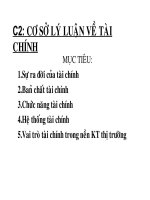Tài liệu Giáo trình: Marketing Management_ Chapter 03 pptx
Bạn đang xem bản rút gọn của tài liệu. Xem và tải ngay bản đầy đủ của tài liệu tại đây (378.15 KB, 35 trang )
3 - 1
Chapter
Chapter
3
3
Marketing
Marketing
Research
Research
3 - 2
Key Learning Points
Key Learning Points
The scope of marketing research activities
The scope of marketing research activities
Where to find secondary sources of
Where to find secondary sources of
information
information
Primary sources of marketing research
Primary sources of marketing research
information
information
Developing estimates of market potential
Developing estimates of market potential
Developing sales forecasts
Developing sales forecasts
The impact of the Internet on marketing
The impact of the Internet on marketing
research
research
3 - 3
Marketing Research
Marketing Research
Three Major Functions of Research
Three Major Functions of Research
–
–
Scanning for opportunities and threats.
Scanning for opportunities and threats.
•
•
Markets, competitors, technology, and
Markets, competitors, technology, and
regulatory, economic, political, social, and
regulatory, economic, political, social, and
cultural environments
cultural environments
–
–
Risk assessment of future programs.
Risk assessment of future programs.
•
•
Current customers, competitors
Current customers, competitors
’
’
customers,
customers,
nonusers
nonusers
–
–
Monitoring of current programs.
Monitoring of current programs.
•
•
Performance evaluation of all segments
Performance evaluation of all segments
3 - 4
Figure 3-1:
Overview of the
Marketing Research Process
3 - 5
Product & Service
Product & Service
Decisions
Decisions
“
“
Secondary information sources
Secondary information sources
are those that already exist and
are those that already exist and
were not developed for the
were not developed for the
particular problem at hand.
particular problem at hand.
”
”
“
“
Primary information sources are
Primary information sources are
those that are generated for the
those that are generated for the
particular problem being studied.
particular problem being studied.
”
”
3 - 5
- Russell S. Winer
3 - 6
Product & Service
Product & Service
Decisions
Decisions
Key Decisions
Key Decisions
The Research Process
The Research Process
Data Sources
Data Sources
Secondary
Secondary
–
–
Internal
Internal
–
–
External
External
Primary
Primary
–
–
Informal
Informal
–
–
Qualitative
Qualitative
Observations
Observations
3 - 6
Surveys
Surveys
–
–
Personal
Personal
–
–
Phone
Phone
–
–
–
–
Internet
Internet
Models and
Models and
Simulations
Simulations
Panels
Panels
–
–
Continuous
Continuous
reporting
reporting
–
–
Special
Special
purpose
purpose
–
–
Scanner
Scanner
Experiments
Experiments
3 - 7
The Research Process
The Research Process
Internal Secondary Data Sources
Internal Secondary Data Sources
–
–
Internal sources of information
Internal sources of information
exist within the organization.
exist within the organization.
•
•
Past marketing plans
Past marketing plans
•
•
Sales call reports
Sales call reports
•
•
Transaction information
Transaction information
•
•
Reverse engineering or
Reverse engineering or
benchmarking reports
benchmarking reports
•
•
Web site visitation information
Web site visitation information
3 - 8
The Research Process
The Research Process
Internal Secondary Data Sources
Internal Secondary Data Sources
–
–
Intranets share information in
Intranets share information in
multinational organizations
multinational organizations
–
–
Key problem with internal
Key problem with internal
information is obtaining
information is obtaining
information in a usable format
information in a usable format
–
–
Territorialism can be a problem
Territorialism can be a problem
when other departments are
when other departments are
unwilling to share information
unwilling to share information
3 - 9
The Research Process
The Research Process
External Secondary Data Sources
External Secondary Data Sources
–
–
Trade associations
Trade associations
–
–
General business publications (e.g.
General business publications (e.g.
Wall
Wall
Street Journal
Street Journal
)
)
–
–
Trade publications (e.g.
Trade publications (e.g.
Adweek
Adweek
)
)
–
–
Academic publications (e.g.
Academic publications (e.g.
Journal of
Journal of
Advertising
Advertising
)
)
–
–
Corporate reports
Corporate reports
–
–
Government publications and census
Government publications and census
3 - 10
Not all information posted
Not all information posted
to the web is equally
to the web is equally
reliable. What factors
reliable. What factors
would you consider in
would you consider in
evaluating the
evaluating the
quality
quality
of
of
the secondary data?
the secondary data?
Discussion Question
Visiting Yahoo! and
Visiting Yahoo! and
searching on the topic of
searching on the topic of
your choice will yield
your choice will yield
thousands of
thousands of
“
“
hits.
hits.
”
”
Click the graphic above to link to Yahoo!
Click the graphic above to link to Yahoo!
3 - 11
The Research Process
The Research Process
Primary Data Sources
Primary Data Sources
–
–
Informal
Informal
•
•
Not representative samples.
Not representative samples.
•
•
Useful in helping to form hypotheses
Useful in helping to form hypotheses
to be tested via more formal research.
to be tested via more formal research.
•
•
Information should be obtained from
Information should be obtained from
both channel members (wholesalers,
both channel members (wholesalers,
distributors, retailers) and users.
distributors, retailers) and users.
•
•
Mystery shoppers
Mystery shoppers
3 - 12
The Research Process
The Research Process
Primary Data Sources: Types of
Primary Data Sources: Types of
Qualitative Research
Qualitative Research
–
–
Phenomenological
Phenomenological
•
•
Seeks to understand how consumers use
Seeks to understand how consumers use
products in everyday life
products in everyday life
–
–
Exploratory
Exploratory
•
•
Used to generate hypotheses for further
Used to generate hypotheses for further
testing
testing
–
–
Clinical
Clinical
•
•
Explores the motivation and reasoning
Explores the motivation and reasoning
behind consumer purchasing behavior
behind consumer purchasing behavior
3 - 13
The Research Process
The Research Process
Qualitative Research: Focus Groups
Qualitative Research: Focus Groups
–
–
May be used for exploratory, clinical, or
May be used for exploratory, clinical, or
phenomenological purposes
phenomenological purposes
–
–
Small groups
Small groups
(typically no more
(typically no more
than 12 people)
than 12 people)
–
–
Moderators guide
Moderators guide
the discussion
the discussion
and report results
and report results
3 - 14
The Research Process
The Research Process
Qualitative Research: Focus Groups
Qualitative Research: Focus Groups
–
–
Results are not
Results are not
generalizable
generalizable
–
–
Most misused research technique
Most misused research technique
–
–
Videoconference,
Videoconference,
telephone, and
telephone, and
web
web
-
-
based focus
based focus
groups are
groups are
increasing
increasing
3 - 15
The Research Process
The Research Process
Primary Research: Observations
Primary Research: Observations
and Ethnographic Research
and Ethnographic Research
–
–
Observation research
Observation research
•
•
One
One
-
-
way mirrors
way mirrors
•
•
In
In
-
-
home product audits
home product audits
•
•
Pupil dilation and physiological measures
Pupil dilation and physiological measures
–
–
Ethnographic research
Ethnographic research
•
•
Researchers are often trained in
Researchers are often trained in
anthropological training
anthropological training
–
–
Virtual shopping
Virtual shopping
3 - 16
The Research Process
The Research Process
Primary Research: Surveys
Primary Research: Surveys
–
–
Questionnaires are administered as a
Questionnaires are administered as a
form of quantitative research
form of quantitative research
•
•
Descriptive surveys are undertaken to
Descriptive surveys are undertaken to
collect facts (e.g. describe demographic or
collect facts (e.g. describe demographic or
lifestyle characteristics of segment)
lifestyle characteristics of segment)
•
•
Scientific surveys test hypotheses
Scientific surveys test hypotheses
–
–
Key issues in survey design
Key issues in survey design
•
•
Sampling considerations
Sampling considerations
•
•
Type of survey to be used
Type of survey to be used
3 - 17
The Research Process
The Research Process
Sampling considerations
Sampling considerations
–
–
Population or
Population or
“
“
universe
universe
”
”
from which
from which
the sample is drawn
the sample is drawn
•
•
Biased samples are not representative;
Biased samples are not representative;
results can not be generalized
results can not be generalized
–
–
Sampling method
Sampling method
•
•
Random (probability) samples are preferred
Random (probability) samples are preferred
as each member of the population has a
as each member of the population has a
known, nonzero chance of being selected
known, nonzero chance of being selected
–
–
Nonresponse
Nonresponse
bias can also damage the
bias can also damage the
validity of the results
validity of the results
3 - 18
The Research Process
The Research Process
Personal
Personal
Interview
Interview
Phone
Phone
Internet
Internet
High cost
High cost
High degree of control
High degree of control
over data collection
over data collection
High response rate
High response rate
High potential for
High potential for
interviewer bias
interviewer bias
Long time to obtain data
Long time to obtain data
High flexibility in terms
High flexibility in terms
of survey format and
of survey format and
question types
question types
Low
Low
nonresponse
nonresponse
bias
bias
Survey Types
Survey Types
3 - 19
The Research Process
The Research Process
Personal
Personal
Interview
Interview
Phone
Phone
Internet
Internet
Medium cost
Medium cost
Medium degree of
Medium degree of
control over data
control over data
collection process
collection process
Medium response rate
Medium response rate
Medium potential for
Medium potential for
interviewer bias
interviewer bias
Short time to obtain
Short time to obtain
data
data
Medium flexibility
Medium flexibility
Low
Low
nonresponse
nonresponse
bias
bias
Key Strategies
Key Strategies
3 - 20
The Research Process
The Research Process
Personal
Personal
Interview
Interview
Phone
Phone
Internet
Internet
Low cost
Low cost
Low degree of control
Low degree of control
over data collection
over data collection
process
process
Low response rate
Low response rate
Low potential for
Low potential for
interviewer bias
interviewer bias
Long time to obtain
Long time to obtain
data
data
Low flexibility
Low flexibility
High
High
nonresponse
nonresponse
bias
bias
Key Strategies
Key Strategies
3 - 21
The Research Process
The Research Process
Personal
Personal
Interview
Interview
Phone
Phone
Internet
Internet
Low cost
Low cost
Low degree of control
Low degree of control
over data collection
over data collection
process
process
Low response rate
Low response rate
Low potential for
Low potential for
interviewer bias
interviewer bias
Short time to obtain
Short time to obtain
data
data
Medium flexibility
Medium flexibility
High
High
nonresponse
nonresponse
bias
bias
Key Strategies
Key Strategies
3 - 22
Product & Service
Product & Service
Decisions
Decisions
“
“
A panel is a set of customers
A panel is a set of customers
who are enlisted to give responses
who are enlisted to give responses
to questions or to provide data
to questions or to provide data
repeatedly over a period of time.
repeatedly over a period of time.
The main benefit of a panel is the
The main benefit of a panel is the
ability to observe changes in
ability to observe changes in
behavior caused by changes in
behavior caused by changes in
marketing variables or other
marketing variables or other
factors in the marketplace.
factors in the marketplace.
”
”
3 - 22
- Russell S. Winer
3 - 23
The Research Process
The Research Process
Primary Data Source: Panels
Primary Data Source: Panels
–
–
Provide both cross
Provide both cross
-
-
sectional and time
sectional and time
-
-
series
series
data.
data.
–
–
Several problems with panel data:
Several problems with panel data:
•
•
Panel member dropout (mortality)
Panel member dropout (mortality)
•
•
Sample is not always representative
Sample is not always representative
•
•
Panel conditioning may occur
Panel conditioning may occur
–
–
Types of panels:
Types of panels:
•
•
Continuous reporting panels
Continuous reporting panels
•
•
Scanner panel
Scanner panel
•
•
Special
Special
-
-
purpose panels
purpose panels
3 - 24
The Research Process
The Research Process
Primary Data Source: Experiments
Primary Data Source: Experiments
–
–
Experiments are the only legitimate
Experiments are the only legitimate
method of determining cause & effect.
method of determining cause & effect.
–
–
Experimental Features:
Experimental Features:
•
•
Manipulation
Manipulation
•
•
Control group
Control group
•
•
External validity
External validity
•
•
Internal validity
Internal validity
–
–
Experiments can be conducted in the
Experiments can be conducted in the
laboratory or field.
laboratory or field.
3 - 25
The Research Process
The Research Process
Primary Data Source: Models and
Primary Data Source: Models and
Simulations
Simulations
–
–
Developed to simulate a particular
Developed to simulate a particular
marketing problem.
marketing problem.
–
–
Regression is typically used to estimate
Regression is typically used to estimate
the mathematical relationships between
the mathematical relationships between
two controllable marketing variables.
two controllable marketing variables.









